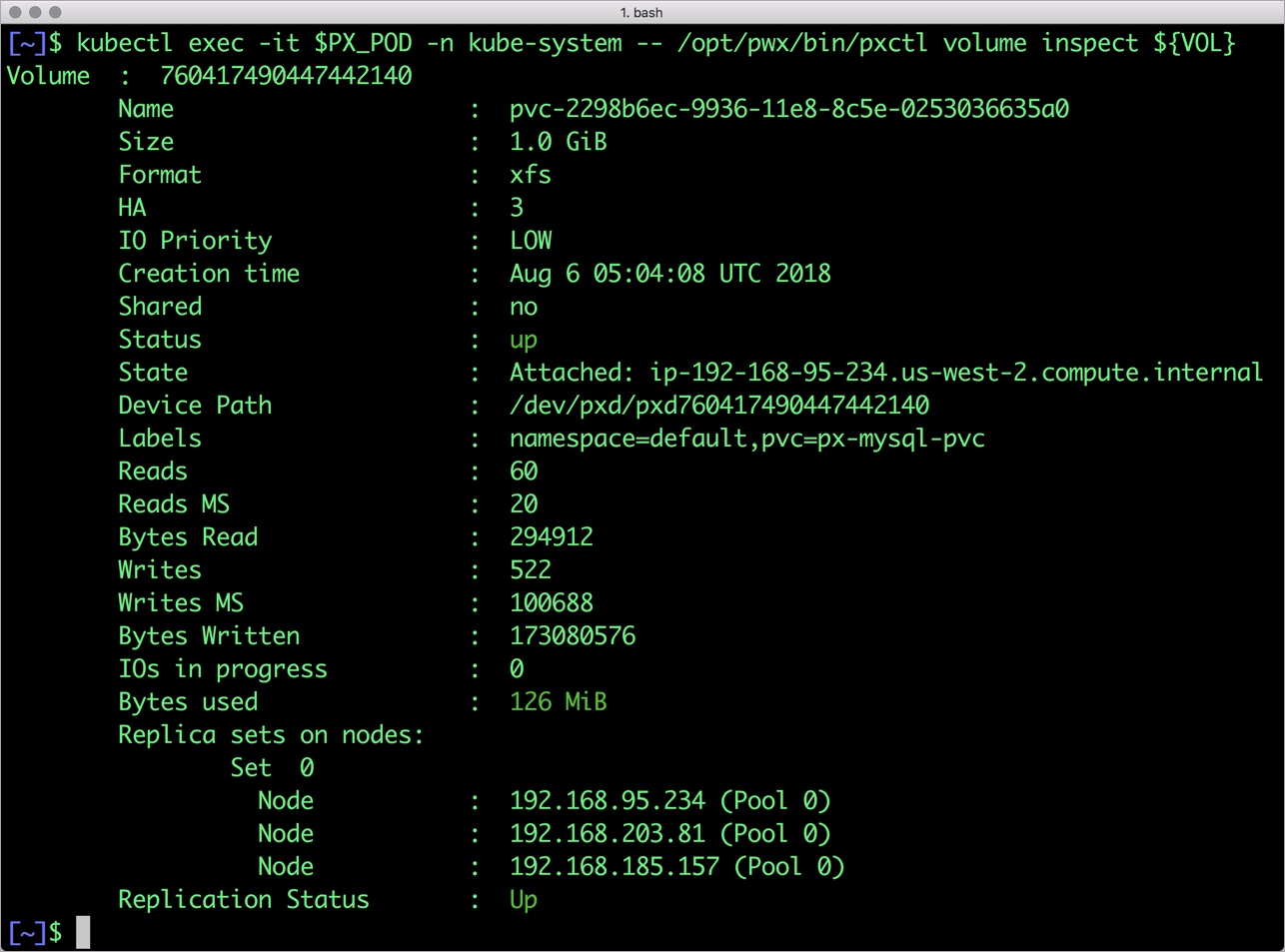
This post is part of our ongoing series on running MariaDB on Kubernetes. We’ve published a number of articles about running MariaDB on Kubernetes for specific platforms and for specific use cases. If you are looking for a specific Kubernetes platform, check out these related articles.
Running HA MariaDB on Google Kubernetes Engine (GKE)
Running HA MariaDB on Azure Kubernetes Service (AKS)
Running HA MariaDB on Red Hat OpenShift
Running HA MariaDB with Rancher Kubernetes Engine (RKE)
And now, onto the post…
Amazon EKS is a fully managed Kubernetes environment running in AWS. With Amazon EKS customers get a highly-available, secure Kubernetes control plane without needing to worry about provisioning, upgrades, or patching. Amazon EKS is certified by the Cloud Native Computing Foundation (CNCF) as Kubernetes conformant, which means it supports all existing plugins and tooling from the Kubernetes community, including Portworx.
Portworx, an EKS launch partner, is a cloud native storage platform to run persistent workloads deployed on a variety of orchestration engines including Kubernetes. With Portworx, customers can manage the database of their choice on any infrastructure using any container scheduler. It provides a single data management layer for all stateful services, no matter where they run.
This tutorial is a walk-through of the steps involved in deploying and managing a highly available MariaDB database on Amazon EKS.
In summary, to run HA MariaDB on Amazon you need to:
- Install an EKS cluster by following instructions in the Amazon docs
- Install a cloud native storage solution like Portworx as a DaemonSet on EKS
- Create a storage class defining your storage requirements like replication factor, snapshot policy, and performance profile
- Deploy MariaDB using Kubernetes
- Test failover by killing or cordoning nodes in your cluster
How to set up an EKS cluster
Portworx is fully supported on Amazon EKS. Please follow the instructions to configure an Amazon EKS cluster.
You should have a three node Kubernetes cluster deployed based on the default EKS configuration.
$ kubectl get nodes NAME STATUS ROLES AGE VERSION ip-192-168-128-254.us-west-2.compute.internal Ready none 8d v1.10.3 ip-192-168-217-164.us-west-2.compute.internal Ready none 8d v1.10.3 ip-192-168-94-92.us-west-2.compute.internal Ready none 8d v1.10.3

Installing Portworx in EKS
Installing Portworx on Amazon EKS is not very different from installing it on a Kubernetes cluster setup through Kops. Portworx EKS documentation has the steps involved in running the Portworx cluster in a Kubernetes environment deployed in AWS.
Portworx cluster need to be up and running on EKS before proceeding to the next step. The kube-system namespace should have the Portworx pods in running state.
$ kubectl get pods -n=kube-system -l name=portworx NAME READY STATUS RESTARTS AGE portworx-blqjh 1/1 Running 0 8d portworx-c8bf2 1/1 Running 0 8d portworx-z2j6z 1/1 Running 0 8d

Creating a storage class for MariaDB
Once the EKS cluster is up and running, and Portworx is installed and configured, we will deploy a highly available MariaDB database.
Through storage class objects, an admin can define different classes of Portworx volumes that are offered in a cluster. These classes will be used during the dynamic provisioning of volumes. The Storage Class defines the replication factor, I/O profile (e.g., for a database or a CMS), and priority (e.g., SSD or HDD). These parameters impact the availability and throughput of workloads and can be specified for each volume. This is important because a production database will have different requirements than a development Jenkins cluster.
In this example, the storage class that we deploy has a replication factor of 3 with I/O profile set to “db,” and priority set to “high.” This means that the storage will be optimized for low latency database workloads like MariaDB and automatically placed on the highest performance storage available in the cluster.
$ cat > px-mariadb-sc.yaml << EOF
kind: StorageClass
apiVersion: storage.k8s.io/v1beta1
metadata:
name: px-ha-sc
provisioner: kubernetes.io/portworx-volume
parameters:
repl: "3"
EOF
$ kubectl create -f px-mariadb-sc.yaml storageclass.storage.k8s.io "px-ha-sc" created
$ kubectl get sc NAME PROVISIONER AGE px-ha-sc kubernetes.io/portworx-volume 10s stork-snapshot-sc stork-snapshot 3d
Creating a MariaDB PVC on Kubernetes
We can now create a Persistent Volume Claim (PVC) based on the Storage Class. Thanks to dynamic provisioning, the claims will be created without explicitly provisioning Persistent Volume (PV).
$ cat > px-mariadb-pvc.yaml << EOF
kind: PersistentVolumeClaim
apiVersion: v1
metadata:
name: px-mariadb-pvc
annotations:
volume.beta.kubernetes.io/storage-class: px-ha-sc
spec:
accessModes:
- ReadWriteOnce
resources:
requests:
storage: 1Gi
EOF
$ kubectl create -f px-mariadb-pvc.yaml
persistentvolumeclaim "mariadb" created
$ kubectl get pvc
NAME STATUS VOLUME CAPACITY ACCESS MODES STORAGECLASS AGE
px-mariadb-pvc Bound pvc-3a6788df-9274-11e8-8c5e-0253036635a0 1Gi RWO px-ha-sc 17s
Deploying MariaDB on EKS
Finally, let’s create a MariaDB instance as a Kubernetes deployment object. For simplicity’s sake, we will just be deploying a single MariaDB pod. Because Portworx provides synchronous replication for High Availability, a single MariaDB instance might be the best deployment option for your MariaDB database. Portworx can also provide backing volumes for multi-node MariaDB cluster. The choice is yours.
$ cat > px-mariadb-app.yaml << EOF
apiVersion: apps/v1
kind: Deployment
metadata:
name: mariadb
spec:
selector:
matchLabels:
app: mariadb
strategy:
rollingUpdate:
maxSurge: 1
maxUnavailable: 1
type: RollingUpdate
replicas: 1
template:
metadata:
labels:
app: mariadb
spec:
schedulerName: stork
containers:
- name: mariadb
image: mariadb:latest
imagePullPolicy: "Always"
env:
- name: MYSQL_ROOT_PASSWORD
value: password
ports:
- containerPort: 3306
volumeMounts:
- mountPath: /var/lib/mysql
name: mariadb-data
volumes:
- name: mariadb-data
persistentVolumeClaim:
claimName: px-mariadb-pvc
EOF
$ kubectl create -f px-mariadb-app.yaml deployment.extensions "mariadb" created
The MariaDB deployment defined above is explicitly associated with the PVC, px-mariadb-pvc created in the previous step.
This deployment creates a single pod running MariaDB backed by Portworx.
$ kubectl get pods NAME READY STATUS RESTARTS AGE mariadb-dff54d66d-m9r6q 1/1 Running 0 6s
We can inspect the Portworx volume by accessing the pxctl tool running with the MariaDB pod.
$ VOL=`kubectl get pvc | grep px-mariadb-pvc | awk '{print $3}'`
$ PX_POD=$(kubectl get pods -l name=portworx -n kube-system -o jsonpath='{.items[0].metadata.name}')
$ kubectl exec -it $PX_POD -n kube-system -- /opt/pwx/bin/pxctl volume inspect ${VOL}
Volume : 760417490447442140
Name : pvc-2298b6ec-9936-11e8-8c5e-0253036635a0
Size : 1.0 GiB
Format : xfs
HA : 3
IO Priority : LOW
Creation time : Aug 6 05:04:08 UTC 2018
Shared : no
Status : up
State : Attached: ip-192-168-95-234.us-west-2.compute.internal
Device Path : /dev/pxd/pxd760417490447442140
Labels : namespace=default,pvc=px-mariadb-pvc
Reads : 60
Reads MS : 20
Bytes Read : 294912
Writes : 512
Writes MS : 100644
Bytes Written : 172474368
IOs in progress : 0
Bytes used : 126 MiB
Replica sets on nodes:
Set 0
Node : 192.168.95.234 (Pool 0)
Node : 192.168.203.81 (Pool 0)
Node : 192.168.185.157 (Pool 0)
Replication Status : Up
The screenshot looks similar to the one shown below:

The output from the above command confirms the creation of volumes that are backing MariaDB database instance.
Failing over MariaDB pod on Kubernetes
Populating sample data
Let’s populate the database with some sample data.
We will first find the pod that’s running MariaDB to access the shell.
$ POD=`kubectl get pods -l app=mariadb | grep Running | grep 1/1 | awk '{print $1}'`
$ kubectl exec -it $POD -- mysql -uroot -ppassword
Welcome to the MariaDB monitor. Commands end with ; or \g.
Your MariaDB connection id is 11
Server version: 10.4.6-MariaDB-1:10.4.6+maria~bionic mariadb.org binary distribution
Copyright (c) 2000, 2018, Oracle, MariaDB Corporation Ab and others.
Type 'help;' or '\h' for help. Type '\c' to clear the current input statement.
MariaDB [(none)]>
Now that we are inside the shell, we can populate create a sample database and table.
MariaDB> CREATE DATABASE `classicmodels`;
MariaDB> USE `classicmodels`;
MariaDB> CREATE TABLE `offices` (
`officeCode` varchar(10) NOT NULL,
`city` varchar(50) NOT NULL,
`phone` varchar(50) NOT NULL,
`addressLine1` varchar(50) NOT NULL,
`addressLine2` varchar(50) DEFAULT NULL,
`state` varchar(50) DEFAULT NULL,
`country` varchar(50) NOT NULL,
`postalCode` varchar(15) NOT NULL,
`territory` varchar(10) NOT NULL,
PRIMARY KEY (`officeCode`)
) ENGINE=InnoDB DEFAULT CHARSET=latin1;
Query OK, 0 rows affected (0.227 sec)
MariaDB> insert into `offices`(`officeCode`,`city`,`phone`,`addressLine1`,`addressLine2`,`state`,`country`,`postalCode`,`territory`) values
('1','San Francisco','+1 650 219 4782','100 Market Street','Suite 300','CA','USA','94080','NA'),
('2','Boston','+1 215 837 0825','1550 Court Place','Suite 102','MA','USA','02107','NA'),
('3','NYC','+1 212 555 3000','523 East 53rd Street','apt. 5A','NY','USA','10022','NA'),
('4','Paris','+33 14 723 4404','43 Rue Jouffroy D\'abbans',NULL,NULL,'France','75017','EMEA'),
('5','Tokyo','+81 33 224 5000','4-1 Kioicho',NULL,'Chiyoda-Ku','Japan','102-8578','Japan'),
('6','Sydney','+61 2 9264 2451','5-11 Wentworth Avenue','Floor #2',NULL,'Australia','NSW 2010','APAC'),
('7','London','+44 20 7877 2041','25 Old Broad Street','Level 7',NULL,'UK','EC2N 1HN','EMEA');
Query OK, 7 rows affected (0.039 sec)
Records: 7 Duplicates: 0 Warnings: 0
Let’s run a few queries on the table.
MariaDB> select `officeCode`,`city`,`phone`,`addressLine1`,`city` from `offices`; +------------+---------------+------------------+--------------------------+---------------+ | officeCode | city | phone | addressLine1 | city | +------------+---------------+------------------+--------------------------+---------------+ | 1 | San Francisco | +1 650 219 4782 | 100 Market Street | San Francisco | | 2 | Boston | +1 215 837 0825 | 1550 Court Place | Boston | | 3 | NYC | +1 212 555 3000 | 523 East 53rd Street | NYC | | 4 | Paris | +33 14 723 4404 | 43 Rue Jouffroy D'abbans | Paris | | 5 | Tokyo | +81 33 224 5000 | 4-1 Kioicho | Tokyo | | 6 | Sydney | +61 2 9264 2451 | 5-11 Wentworth Avenue | Sydney | | 7 | London | +44 20 7877 2041 | 25 Old Broad Street | London | +------------+---------------+------------------+--------------------------+---------------+ 7 rows in set (0.01 sec)

Find all the offices in USA.
MariaDB [classicmodels]> select `officeCode`, `city`, `phone` from `offices` where `country` = "USA"; +------------+---------------+-----------------+ | officeCode | city | phone | +------------+---------------+-----------------+ | 1 | San Francisco | +1 650 219 4782 | | 2 | Boston | +1 215 837 0825 | | 3 | NYC | +1 212 555 3000 | +------------+---------------+-----------------+ 3 rows in set (0.00 sec)
Exit from the MariaDB shell to return to the host.
Simulating node failure
Now, let’s simulate the node failure by cordoning off the node on which MariaDB is running.
$ NODE=`kubectl get pods -l app=mariadb -o wide | grep -v NAME | awk '{print $7}'`
$ kubectl cordon ${NODE}
node "ip-192-168-203-81.us-west-2.compute.internal" cordoned
The above command disabled scheduling on one of the nodes.
$ kubectl get nodes NAME STATUS ROLES AGE VERSION ip-192-168-185-157.us-west-2.compute.internal Ready 4h v1.10.3 ip-192-168-203-81.us-west-2.compute.internal Ready,SchedulingDisabled 4h v1.10.3 ip-192-168-95-234.us-west-2.compute.internal Ready 4h v1.10.3
Now, let’s go ahead and delete the MariaDB pod.
$ POD=`kubectl get pods -l app=mariadb -o wide | grep -v NAME | awk '{print $1}'`
$ kubectl delete pod ${POD}
pod "mariadb-dff54d66d-m9r6q" deleted
As soon as the pod is deleted, it is relocated to the node with the replicated data. STorage ORchestrator for Kubernetes (STORK), a Portworx-contributed open source storage scheduler, co-locates the pod on the exact node where the data is stored. It ensures that an appropriate node is selected for scheduling the pod.
Let’s verify this by running the below command. We will notice that a new pod has been created and scheduled in a different node.
$ kubectl get pods -l app=mariadb -o wide NAME READY STATUS RESTARTS AGE IP NODE mariadb-dff54d66d-tzvjw 1/1 Running 0 15s 192.168.86.169 ip-192-168-95-234.us-west-2.compute.internal
$ kubectl uncordon ${NODE}
node "ip-192-168-203-81.us-west-2.compute.internal" uncordoned
Finally, let’s verify that the data is still available.
Verifying that the data is intact
Let’s find the pod name and run the ‘exec’ command, and then access the MariaDB shell.
kubectl exec -it $POD -- mysql -uroot -ppassword Welcome to the MariaDB monitor. Commands end with ; or \g. Your MariaDB connection id is 8 Server version: 10.4.6-MariaDB-1:10.4.6+maria~bionic mariadb.org binary distribution Copyright (c) 2000, 2018, Oracle, MariaDB Corporation Ab and others. Type 'help;' or '\h' for help. Type '\c' to clear the current input statement. MariaDB [(none)]>
We will query the database to verify that the data is intact.
MariaDB [none]> USE `classicmodels`; MariaDB [classicmodels]> select `officeCode`, `city`, `phone` from `offices` where `country` = "USA"; +------------+---------------+-----------------+ | officeCode | city | phone | +------------+---------------+-----------------+ | 1 | San Francisco | +1 650 219 4782 | | 2 | Boston | +1 215 837 0825 | | 3 | NYC | +1 212 555 3000 | +------------+---------------+-----------------+ 3 rows in set (0.00 sec)
Observe that the database table is still there and all the content is intact! Exit from the client shell to return to the host.
Performing Storage Operations on MariaDB
After testing end-to-end failover of the database, let’s perform StorageOps on our EKS cluster.
Expanding the Kubernetes Volume with no downtime
Currently, the Portworx volume that we created at the beginning is of 1Gib size. We will now expand it to double the storage capacity.
First, let’s get the volume name and inspect it through the pxctl tool.
If you have access, SSH into one of the nodes and run the following command.
$ POD=`/opt/pwx/bin/pxctl volume list --label pvc=px-mariadb-pvc | grep -v ID | awk '{print $1}'`
$ /opt/pwx/bin/pxctl v i $POD
Volume : 760417490447442140
Name : pvc-3a6788df-9274-11e8-8c5e-0253036635a0
Size : 1.0 GiB
Format : xfs
HA : 3
IO Priority : LOW
Creation time : Jul 28 14:40:52 UTC 2018
Shared : no
Status : up
State : Attached: ip-192-168-95-234.us-west-2.compute.internal
Device Path : /dev/pxd/pxd150455926773027922
Labels : namespace=default,pvc=px-mariadb-pvc
Reads : 188
Reads MS : 104
Bytes Read : 8458240
Writes : 23
Writes MS : 128
Bytes Written : 2347008
IOs in progress : 0
Bytes used : 126 MiB
Replica sets on nodes:
Set 0
Node : 192.168.95.234 (Pool 0)
Node : 192.168.203.81 (Pool 0)
Node : 192.168.185.157 (Pool 0)
Replication Status : Up
Notice the current Portworx volume. It is 1GiB. Let’s expand it to 2GiB.
$ /opt/pwx/bin/pxctl volume update $POD --size=2 Update Volume: Volume update successful for volume 150455926773027922
Check the new volume size.
$ /opt/pwx/bin/pxctl v i $POD Volume : 760417490447442140 Name : pvc-3a6788df-9274-11e8-8c5e-0253036635a0 Size : 2.0 GiB Format : xfs HA : 3 IO Priority : LOW Creation time : Jul 28 14:40:52 UTC 2018 Shared : no Status : up State : Attached: ip-192-168-95-234.us-west-2.compute.internal Device Path : /dev/pxd/pxd150455926773027922 Labels : namespace=default,pvc=px-mariadb-pvc Reads : 200 Reads MS : 104 Bytes Read : 8507392 Writes : 60 Writes MS : 164 Bytes Written : 2498560 IOs in progress : 0 Bytes used : 126 MiB Replica sets on nodes: Set 0 Node : 192.168.95.234 (Pool 0) Node : 192.168.203.81 (Pool 0) Node : 192.168.185.157 (Pool 0) Replication Status : Up

Taking Snapshots of a Kubernetes volume and restoring the database
Portworx supports creating snapshots for Kubernetes PVCs.
Let’s create a snapshot for the Kubernetes PVC we created for MariaDB.
cat > px-mariadb-snap.yaml << EOF apiVersion: volumesnapshot.external-storage.k8s.io/v1 kind: VolumeSnapshot metadata: name: px-mariadb-snapshot namespace: default spec: persistentVolumeClaimName: px-mariadb-pvc EOF
$ kubectl create -f px-mariadb-snap.yaml volumesnapshot.volumesnapshot.external-storage.k8s.io "px-mariadb-snapshot" created
Verify the creation of volume snapshot.
$ kubectl get volumesnapshot NAME AGE px-mariadb-snapshot 13s
$ kubectl get volumesnapshotdatas NAME AGE k8s-volume-snapshot-504e9e5f-a6ec-11e9-ab32-7a5327be2608 19s
With the snapshot in place, let’s go ahead and delete the database.
$ POD=`kubectl get pods -l app=mariadb | grep Running | grep 1/1 | awk '{print $1}'`
$ kubectl exec -it $POD -- mysql -uroot -ppassword
Welcome to the MariaDB monitor. Commands end with ; or \g.
Your MariaDB connection id is 9
Server version: 10.4.6-MariaDB-1:10.4.6+maria~bionic mariadb.org binary distribution
Copyright (c) 2000, 2018, Oracle, MariaDB Corporation Ab and others.
Type 'help;' or '\h' for help. Type '\c' to clear the current input statement.
MariaDB [(none)]>
drop database classicmodels;
Since snapshots are just like volumes, we can use it to start a new instance of MariaDB. Let’s create a new instance of MariaDB by restoring the snapshot data.
$ cat > px-mariadb-snap-pvc << EOF
apiVersion: v1
kind: PersistentVolumeClaim
metadata:
name: px-mariadb-snap-clone
annotations:
snapshot.alpha.kubernetes.io/snapshot: px-mariadb-snapshot
spec:
accessModes:
- ReadWriteOnce
storageClassName: stork-snapshot-sc
resources:
requests:
storage: 2Gi
EOF
$ kubectl create -f px-mariadb-snap-pvc.yaml
persistentvolumeclaim "px-mariadb-snap-clone" created
From the new PVC, we will create a MariaDB pod.
$ cat < px-mariadb-snap-restore.yaml >> EOF
apiVersion: apps/v1
kind: Deployment
metadata:
name: mariadb
spec:
selector:
matchLabels:
app: mariadb
strategy:
rollingUpdate:
maxSurge: 1
maxUnavailable: 1
type: RollingUpdate
replicas: 1
template:
metadata:
labels:
app: mariadb-snap
spec:
affinity:
nodeAffinity:
requiredDuringSchedulingIgnoredDuringExecution:
nodeSelectorTerms:
- matchExpressions:
- key: px/running
operator: NotIn
values:
- "false"
- key: px/enabled
operator: NotIn
values:
- "false"
spec:
containers:
- name: mariadb
image: mariadb:latest
imagePullPolicy: "Always"
env:
- name: MYSQL_ROOT_PASSWORD
value: password
ports:
- containerPort: 3306
volumeMounts:
- mountPath: /var/lib/mysql
name: mariadb-data
volumes:
- name: mariadb-data
persistentVolumeClaim:
claimName: px-mariadb-snap-clone
EOF
$ kubectl create -f px-mariadb-snap-restore.yaml deployment.extensions "mariadb-snap" created
Verify that the new pod is in the running state.
$ kubectl get pods -l app=mariadb-snap NAME READY STATUS RESTARTS AGE mariadb-snap-655ffd9d67-ff288 1/1 Running 0 15s
Finally, let’s access the sample data created earlier in the walkthrough.
$ POD=`kubectl get pods -l app=mariadb-snap | grep Running | grep 1/1 | awk '{print $1}'`
$ kubectl exec -it $POD -- mysql -uroot -ppassword
Welcome to the MariaDB monitor. Commands end with ; or \g.
Your MariaDB connection id is 8
Server version: 10.4.6-MariaDB-1:10.4.6+maria~bionic mariadb.org binary distribution
Copyright (c) 2000, 2018, Oracle, MariaDB Corporation Ab and others.
Type 'help;' or '\h' for help. Type '\c' to clear the current input statement.
MariaDB [(none)]>
MariaDB [(none)]> USE `classicmodels`;
MariaDB [classicmodels]> select `officeCode`, `city`, `phone` from `offices` where `country` = "USA";
+------------+---------------+-----------------+
| officeCode | city | phone |
+------------+---------------+-----------------+
| 1 | San Francisco | +1 650 219 4782 |
| 2 | Boston | +1 215 837 0825 |
| 3 | NYC | +1 212 555 3000 |
+------------+---------------+-----------------+
3 rows in set (0.00 sec)
Notice that the collection is still there with the data intact. We can also push the snapshot to Amazon S3 if we want to create a Disaster Recovery backup in another region. Portworx snapshots also work with any S3 compatible object storage, so the backup can go to a different cloud or even an on-premises data center. Alternatively, we can stretch a single Portworx cluster across two independent Kubernetes clusters for Zero RPO DR for Kubernetes.
Summary
Portworx can easily be deployed on Amazon Elastic Kubernetes Service to run stateful workloads in production. Through the integration of STORK, DevOps and StorageOps teams can seamlessly run highly-available database clusters in Amazon EKS. They can perform traditional operations such as volume expansion, snapshots, backup and recovery for the cloud-native applications.
Share
Subscribe for Updates
About Us
Portworx is the leader in cloud native storage for containers.
Thanks for subscribing!

Janakiram MSV
Contributor | Certified Kubernetes Administrator (CKA) and Developer (CKAD)Explore Related Content:
- Amazon EKS
- kubernetes
- mariadb






